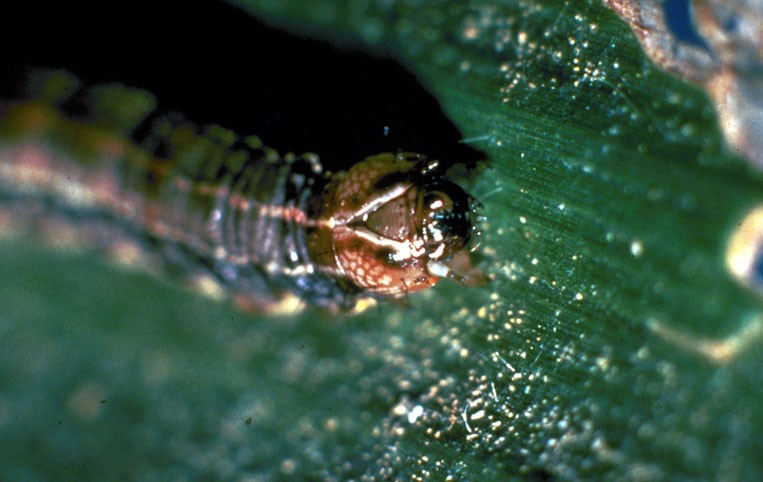Fall armyworm (Spodoptera frugiperda) has recently been found across northern Australia with the most recent detection a moth in Geraldton, Western Australia.
Fall armyworms (image above – source John C. French Sr., Retired, Universities: Auburn, GA, Clemson and U of MO, Bugwood.org) are voracious feeders and are known eat at least 350 species of plants. While they prefer grasses they will also feed on broadleaf crops such as cotton, vegetables and some tree crops as well as native plants and weeds.
Fall armyworm is from the same family (Noctuidae) as Heliothis (Helicoverpa spp.), cutworms and other armyworms. As such the adult moths and caterpillars can be easily confused with related species. Also like related species, the moths are strong flyers and can cover hundreds of kilometres per day. Newly hatched caterpillars can also disperse on silken threads allow them to blow away from egg mass onto other plants.

Fall armyworm moth – they look very similar to other noctuid moths. Source: Robert J. Bauernfeind, Kansas State University, Bugwood.org
Fall armyworm are native to the Americas. In North America moths migrate northward along the east coast as far as Canada during the summer.
They were accidentally introduced to Africa in 2016 and have rapidly spread across that continent. It then spread east to the Indian subcontinent in 2018 and was found in East Asia in 2019. Fall armyworm were first detected in the Torres Strait islands in January 2020 and then quickly spread south in Queensland to Bowen. In March moths were trapped in Darwin and down to Katherine in the Northern Territory. They were confirmed at Kununurra on April 1 and were confirmed in Carnarvon April 28 and then at Geraldton on July 23.
Fall armyworm have an ideal temperature range for development between 23 and 30° C. They have an impressive rate of reproduction with females laying between 1000 and 2000 eggs in their lifetime. In tropical and subtropical areas they have a generation time of 30 days (@ 28° C) which leads to multiple generations per season when food is available. Unlike Heliothis there is no diapause (hibernation of pupae). Fall armyworm are likely to be seasonal pests in southern Australia where temperatures fall below about 10° C and there are frosts.
Moths are very difficult to identify and are easily confused with moths of other closely related species. It is therefore important that suspected moths be correctly identified by an expert entomologist.
Caterpillars hatch and have light-coloured bodies with large dark heads. As they grow they tend to become darker and develop lengthwise stripes and dark spots. Like other Noctuid caterpillars their colour can vary from light green through to black.
An additional key identification feature on larger caterpillars include:
inverted ‘Y’ marking on the head area
pale line along the back
for small spots in a trapezoid on most segments
4 large spots in a square on the 2nd last segment
The Queensland Department of Agriculture and Fisheries have this handy guide to help growers and agronomists in taking better photos of caterpillars to enable rapid identification by an expert. To view click here
Monitoring
Early detection and reporting of fall armyworm will assist in the management and protection of crops. A network of pheromone traps is being established across Australia. These traps attract male moths.
If you live in Western Australia, Northern Territory for Queensland and would like to participate in the surveillance program contact your local state Department of Agriculture for more information.
To find out what is involved in a trapping program download the Department of Primary Industries and Regional Development (WA) surveillance trapping training manual.
Control
Frequent monitoring and early detection are the keys to managing fall armyworm.
Experience in Queensland this year has shown that like other related crop pests focusing on control of small caterpillars is the best approach. Caterpillars that feed in the whorl of maize and sorghum can be protected from insecticides particularly if spray set-ups are not at the optimum. Growers and agronomists need to improve their understanding of band spraying set-ups and how to accurately calculate insecticide rates and application volumes to maximise spray coverage. For more information on this see the GRDC Back Pocket Nozzle Selection guide.
At time of writing there were 35 insecticide permits for a range of crops including maize, sweet corn, rice, cereals, grain sorghum and millet. Go to the APVMA permit search to find which insecticides you can use.
It is likely that insecticide resistance is already present in Australian populations of fall armyworm.
A promising number of parasites, predators and pathogens have already been observed Queensland. Fall armyworm caterpillars will become cannibalistic at higher densities.

Inverted ‘Y’ on head of a fall armyworm caterpillar. Source: Steve L. Brown, University of Georgia, Bugwood.org
Further Resources
Western Australian Department of Primary Industries and Regional Development – This is a very comprehensive set of information on FAW by Dr Helen Safford, based in Kununurra.
https://www.agric.wa.gov.au/plant-biosecurity/fall-armyworm-western-australia
GRDC fall armyworm information
https://grdc.com.au/resources-and-publications/resources/fall-armyworm
Queensland Department of Agriculture and Fisheries
Food and Agriculture Organisation (FAO)
http://www.fao.org/fall-armyworm/en/
Article courtesy of Andrew Storrie, AGRONOMO




